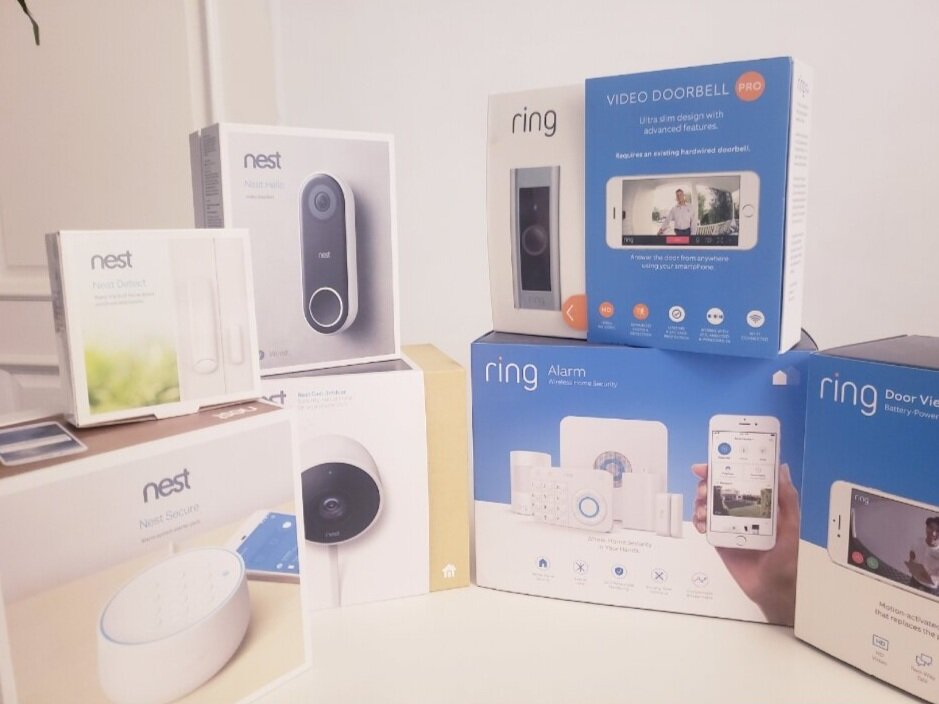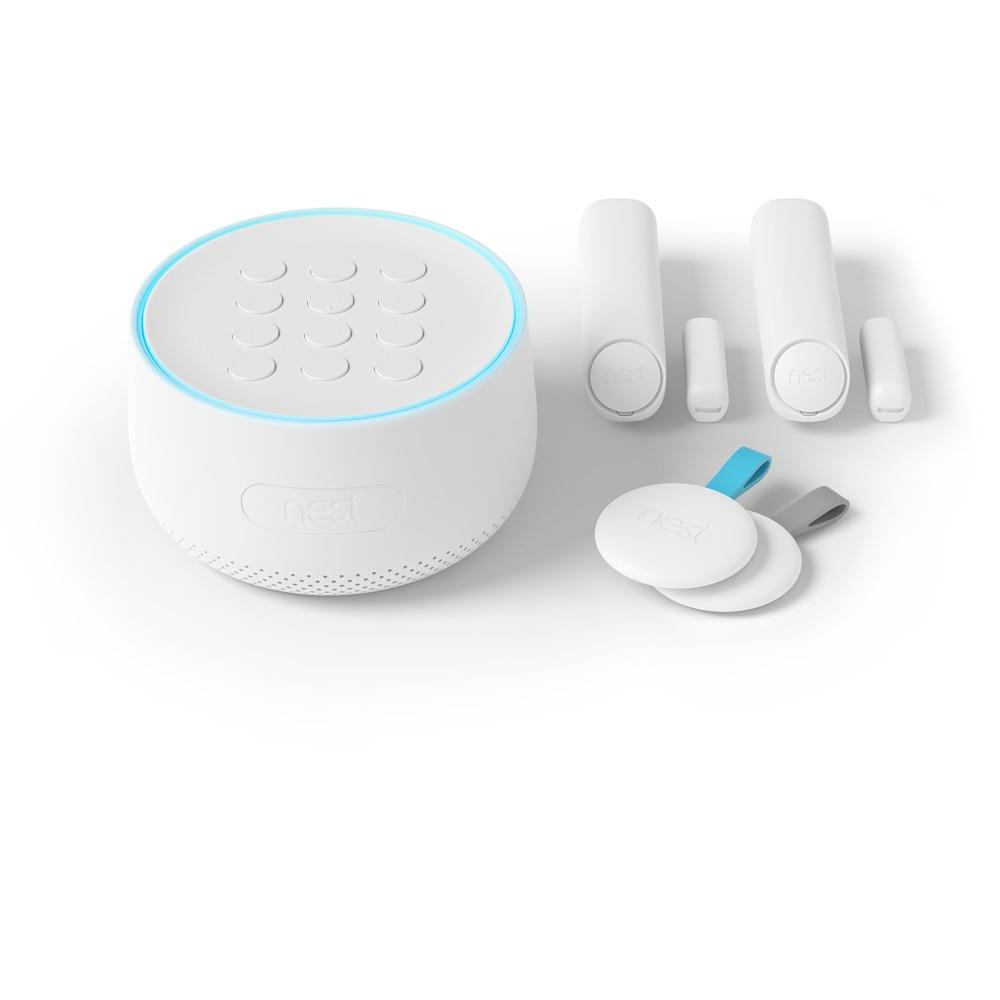Ring vs Nest Security
/Ring vs Nest Security
Ring vs Nest Security, which one should you get? Both are high quality DIY security systems that provide you professional level home security but they work in slightly different ways. We cover what you should know about the Ring vs Nest Security System in our video post below and how you can protect your family with a home alarm system.
Home Security What You Need To Know
Home Security Systems are designed to protect your home and family when you are at home or away from your house. They all operate in a similar way but the basic premise of an alarm system is that when a motion or door sensor is tripped and the alarm is armed, it will go off, creating noise designed to ward off intruders and it will then call the authorities to make sure everything is alright.
Both the Nest and Ring Security Systems work in this way but what’s different about these smart home security systems is that they are designed to work wirelessly so you don’t need to run any wires to install your home security system. Everything is wireless and therefore you don’t need a professional installer to run wires. It’s something you can do yourself in less than an hour for many homes.
The wireless technology that the Ring and Nest security is the same technology that even huge professional security companies now use because it’s much more efficient for installation and allows sensors to be placed everywhere throughout a home.
Both Systems connect to your wifi network, but also have cellular backup in case your internet goes down and both have batteries that will last approximately 24 hours if the power goes.
So What’s Different between “Professional Installation” and DIY Home Security?
These days not much, for the most part the “Professionals” use the same sensors, equipment and technology as the DIY systems just in a different plastic cover with their name on it. When you get a professional home security installation you are paying for the overhead of large traditional company that expects you to pay huge sums monthly for your security system.
They also want to lock you into contracts and make it difficult if you move or need to cancel your alarm system contract. The new DIY systems like Ring Alarm and Nest Alarm systems allow you to pay monthly with no contract and even have a ton of features available for free if you don’t choose professional monitoring, but also can have monthly plans for professional monitoring that are as low as $10 per month.
In my opinion in 2019 you’re not getting anything more from a “Professional Alarm System” and sometimes you get much more out of a DIY security system because they are loaded with the most current features and additional sensors which aren’t often available with traditional security systems.
Nest Alarm System With Nest Motion, Window and Door Sensor
Ring vs Nest Security: Features
Ring Security System
Professional monitoring or Self Monitoring Free
$9.99 per month professional monitoring
Can Arm or Disarm from keypad
Can have more than one keypad
Can Arm or Disarm from phone
Works With Alexa
Cameras and Video Doorbells Available
Motion Sensors Available
Door/Window Sensors Available
Smoke Detectors Available
Freeze Flood Detection
Works With Smart Locks
No Keyfobs
Works on wifi with cellular backup
Easy DIY Installation
Can connect to multiple sirens
Nest Security System
Professional monitoring or Self Monitoring Free
$29.99 per month professional monitoring lower cost with contract.
Can Arm or Disarm from keypad
Can have only one keypad
Can Arm or Disarm from phone
Works with Google Home
Cameras and Smart Video Doorbells Available
Motion Sensors Available (Combo)
Door/Window Sensors Available (Combo)
No Smoke Detection
No Freeze or Flood Detection
Works With Smart Locks
Works With Keyfobs
Works on wifi with cellular backup
Easy DIY Installation
Can connect to only one siren
Ring vs Nest: Key Differences
As you can see in the comparison above both of the security systems have a lot of similar features. However there are a few key differences that I think make a big difference.
Related Post: Full Ring Security Review, Is it the best DIY security system?
Keypads
The first one is in the keypads The Ring Security system has rechargeable battery powered keypads that can be mounted anywhere in your home and you can have multiple keypads, so you could have one at your front door, one in your garage and one in your master bedroom if you wanted. The Nest Hello system only has one keypad that is part of the base station that also has the siren built in and must be plugged in.
I think having the flexibility to have multiple keypads is a big plus and being able to mount them wherever you want is a big plus. The Ring Keypads mount easily to the wall with a snap in bracket and I don’t think I’ve ever had to charge my in the year I’ve had it in service, but if you need to all you do is plug in a cellphone charger and charge it up.
Sensors
Both the Ring and Nest security systems have both motion sensors and open/close sensors otherwise known as window or door sensors. The Nest security system sensors are designed as a combination sensor that includes both motion and open/closed sensors in one sensor. The Ring security system sensors are separate so you have separate open closed, door and window sensors and separate motion sensors.
Because the Nest security system sensors are combination sensors they are typically more expensive than the separate individual Ring Sensors. The other thing is that the Ring Sensors you can place the motion sensors where you want them and not worry about setting them off accidentally because they are combined sensors.
Ring Security System
Ring vs Nest Monthly Cost:
The Ring Alarm system costs $10 per month for 24/7 professional monitoring that will dispatch the authorities if your Alarm is tripped. It also includes 30 days video storage free from an unlimited number of Ring Cameras or Ring Doorbells at one address which makes the Ring Security System a great value if you plan on incorporating wifi security cameras into your home security system.
The Nest Security system costs $29 per month for 24/7 professional monitoring if you don’t want a contract. Or $19.99 if you sign up for a 3 year contract. The professional monitoring will dispatch the authorities if your alarm is tripped. It does not include any video storage and each Nest camera used with the system will have an additional monthly cost of $3-$10.
Contracts
Neither security system requires you to get a contract, but the Nest system does require you to get a contract if you want a lower monthly cost. The Ring system has one low monthly cost that is lower than the Nest Alarm system and has no contract commitment.
Both systems will also work without professional monitoring which means they will still alarm and alert you on your phone when the alarm is tripped. I have found that the Ring Alarm is better suited if you don’t plan on using professional monitoring because you can add multiple sirens to increase the sound level and even place them outside to alert your neighbors that there’s trouble.
Installation
Both Nest and Ring Alarm System offer easy DIY setup and don’t require professional installation. The basic sensors are come with peel and stick adhesive which is similar to gopro adhesive. It’s incredibly strong and as long as you mount the sensors to a clean surface they won’t come off. I’ve had both installed in my home and they haven’t moved or fallen off in over a year.
They also offer the option to screw the sensors into the wall if you prefer by in my experience the the adhesive is enough.
The Nest Alarm System has only one type of sensor a combination motion/door/window sensor. The Ring Security System has vast array of different sensors that can be added to the system which gives you a multiple options for protecting your home. In addition to door/window sensors and motion sensors, the Ring Alarm System also has flood and freeze sensors, smoke and carbon monoxide detectors, alarm listening devices and panic buttons.
Related Post: Ring Flood & Freeze Sensor Review: Can it Save your house from a flood?
Compatibility
The Ring Alarm System works on the Ring App with other Ring devices like the Ring Doorbell, Ring Cameras and Ring Floodlight Cameras. It also acts as a z-wave home automation hub which means that it can connect to z-wave smart home devices like smart locks and smart light switches which you can control from the Ring App.
The Ring Alarm system also work with Alexa which means that you can arm and disarm your security system using your voice and passcode.
The Nest Alarm system works on the Nest App with other Nest devices like the Nest Thermostat, Nest Hello Doorbell, Nest Lock and Nest Cameras. While all of the devices are integrated on one app the devices themselves don’t really communicate much with each other to add functionality.
However the Nest Alarm System works with the Google Home smart assistant and the Google Nest Hub systems which allows you to arm and disarm your alarm system with your voice and Google Assistant.
Ring vs Nest Security: Summary
Both Ring and Nest are capable security systems for your home. However when choosing which alarm system is right for you it’s important to consider the long term monthly cost of the Alarm system and the sensors that are available for each system. If you already have a Nest Thermostat or other Nest products installed maybe you want the connivence of a system that already works with your other smart home devices.
But if you are starting from the ground up the Ring Security system offers a ton of value and options for customization at a lower monthly cost than the Nest security system. I personally have a Ring Security System in my home and don’t intend on switching anytime soon. I love the low cost of the sensors and ability to have multiple keypads.











